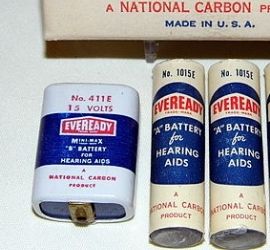What Happened to B Batteries?

Do you need a new battery? You can take a trip to your local hardware store and choose from a wide range. There are AA, AAA, C, and D batteries. However, there are no B batteries to be found. Why is that? Well, the answer is that B batteries still exist, but have more or less disappeared, especially in the U.S.
Since the invention of the battery, a wide variety has been created for a wide range of uses. However, each application required different sizes, shapes, voltages, and storage capacities. Initially, the manufacturer would choose whatever name they wished. As a result, early batteries were referred under a variety of different names. Eventually, it became apparent there needed to be an industry-wide standard. The lack of international or even national standards during WWI presented problems for the military.
After WWI, the War Industries Board and several other government agencies gathered to set standard specifications for batteries. A few years later, in 1928, the American Standards Association met. This was the predecessor to the American National Standards Institute (ANSI). They officially adopted the proposal to list battery cell sizes on their corresponding label. They further suggested adopting a convention using the alphabet. A and B batteries would be the smallest. As you went up in the letters, the batteries would get larger in size.
Uniform Battery Specifications Using the Alphabet
During the World War I era, battery manufacturers and the War Industry Board tried to develop nationally uniform specifications for batteries. In 1924, business and government groups met again to establish a naming system. This was to include all the different batteries that had been standardized a few years earlier. They decided to use the alphabet for the system.
A and B Batteries were the smallest
The smallest-cell batteries were called A and B batteries. The list went on from there. The larger the size, the larger the letter in the alphabet – B, C, and D. As the years passed and battery technology changed, new battery sizes were assigned names.
Newly developed smaller batteries were designated AA and AAA. These new, smaller batteries were perfect for consumer electronics products, and they flourished. C and D batteries also found a foothold in larger applications. But the poor B battery, like the mid-sized A, didn’t have a market and pretty much disappeared in the U.S. Although they’re hard to find, A and B batteries are still out there if you look closely for them. B batteries are still used occasionally in Europe for lanterns and bicycle lamps. However, Energizer says demand is declining. The B battery might be relegated to the same fate as the dinosaur – sooner rather than later.
What Were A and B Batteries Originally Used For?
A and B batteries were used in the early radio industry. The difference in voltage has to do with the way that radio vacuum tubes work. Every radio tube needed a supply of at least two different voltages from A and B batteries. The A voltage heated the filament to release electrons. The B voltage gave the plate a positive charge to attract electrons from the filament.
- Type A batteries – Provide low-voltage DC to heat the filaments inside the radio tubes. It can be as low as 1.5 volts.
- Type B batteries – Provide higher-voltage DC for the plate circuits of the radio tubes. The B supply can be 22.5, 45, 67.5, or 90 volts.
When the A battery is connected, the filament of the tube is heated to release negatively charged electrons. When the B battery is connected, it puts a positive charge on the plate of the tube. Electrons travel through the partial vacuum inside the tube. The electrons flow from the filament to the positively charged plate. Many tubes also had small structures, known as grids, between the filament and the plate. The grid regulates the number of electrons that strike the plate.
Why Did A and B batteries Become Obsolete?
Early radios used batteries. Automobile radios could have their batteries recharged by the car engine while driving. Then technology changed. This is partly because early battery sets had several serious drawbacks. A dead battery would leave a radio useless – possibly in the middle of a crucial broadcast or program. Lead-acid cells could leak acid. They had a nasty habit of dripping from the radio cabinet onto the hardwood floor of the parlor. Sadly, if you accidentally reversed the A and B battery connectors, you could fry your radio’s vacuum tubes. Two developments changed the requirement for batteries in radios:
- AC current for home use – Alternating current became increasingly available in homes during the 1920s. Radio engineers soon developed new radio tubes, called rectifiers, which could convert AC to DC. Soon, the stores were filled with battery-less radio sets using rectifier tubes. Everyone loved these new radios, except the battery manufacturers.
- Solid-state transistors replaced vacuum tubes – Eventually, of course, transistors were developed requiring a fraction of the power. Transistors eliminated the need for the heavy voltage B batteries provided for charging vacuum tube plates.
Radios drove the initial demand for A and B batteries. Without radios, they didn’t have a consumer niche to keep them commercially viable. C and D batteries found their way into products with higher energy demands. The AA and AAA batteries found their way into smaller devices that suited their energy output. There was just no room, or need, for the A and B batteries.
A & B Batteries – Bottom Line
You typically won’t see either A or B batteries on American store shelves. However, they’re still out there. A-size batteries were used in early-model laptop battery packs and some hobby battery packs. B batteries are still sometimes used in Europe for lanterns and bicycle lamps. According to Energizer, their popularity is dwindling there, too. Eventually, they might be completely discontinued.
As battery technology changed, new sizes were made and added to the naming system. When smaller batteries came along, they were designated AA and AAA. These newer batteries were the right size for the growing consumer electronics industry, so they caught on. C and D batteries also found a niche in medium- and high-drain applications. The mid-size A and B batteries simply didn’t have a market and more or less disappeared in the U.S.
Up Next: The Difference Between Bourbon and Whiskey
 Whiskey is an alcoholic spirit. It is fermented and distilled using a combination of wheat, corn, barley, and rye. Then it is aged in wooden barrels. Whiskey is made around the world. Famous varietals include Scotch whisky, Irish whiskey, Bourbon, Canadian whisky, and rye. Whiskey is spelled whisky without an e outside the US and Ireland.
Whiskey is an alcoholic spirit. It is fermented and distilled using a combination of wheat, corn, barley, and rye. Then it is aged in wooden barrels. Whiskey is made around the world. Famous varietals include Scotch whisky, Irish whiskey, Bourbon, Canadian whisky, and rye. Whiskey is spelled whisky without an e outside the US and Ireland.
A whiskey mash is a mixture of fermented grains used in the distilling process. A mash bill identifies what grains are in the mash. Most whiskeys have requirements on what can make up their mash bill. For example, Bourbon’s mash bill must be 51% corn. A sour mash is when a portion of a previous batch of the mash is used in making a new batch. Some distilleries use this to ensure even flavoring, as a type of quality control. Despite the name, this adds no sourness to the flavor profile of the final whiskey.



